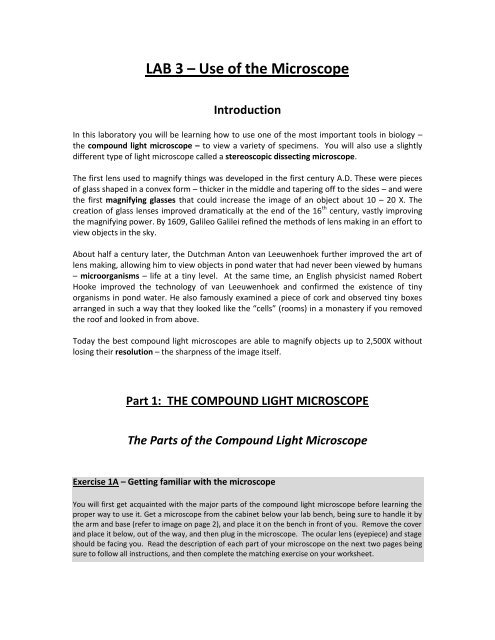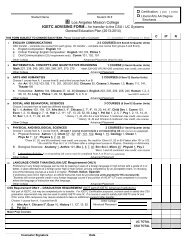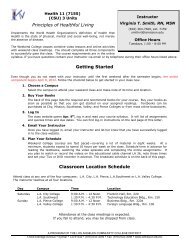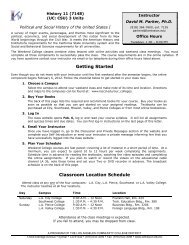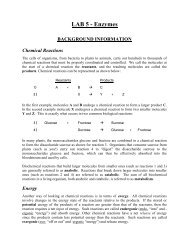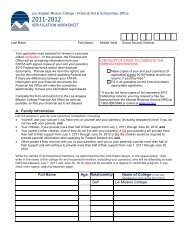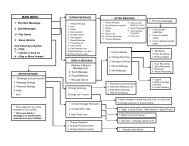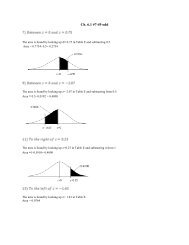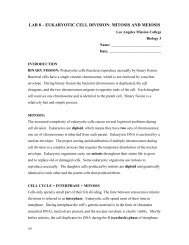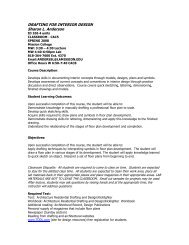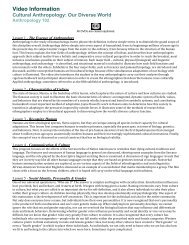Lab #3
Lab #3
Lab #3
Create successful ePaper yourself
Turn your PDF publications into a flip-book with our unique Google optimized e-Paper software.
LAB 3 – Use of the Microscope<br />
Introduction<br />
In this laboratory you will be learning how to use one of the most important tools in biology –<br />
the compound light microscope – to view a variety of specimens. You will also use a slightly<br />
different type of light microscope called a stereoscopic dissecting microscope.<br />
The first lens used to magnify things was developed in the first century A.D. These were pieces<br />
of glass shaped in a convex form – thicker in the middle and tapering off to the sides – and were<br />
the first magnifying glasses that could increase the image of an object about 10 – 20 X. The<br />
creation of glass lenses improved dramatically at the end of the 16 th century, vastly improving<br />
the magnifying power. By 1609, Galileo Galilei refined the methods of lens making in an effort to<br />
view objects in the sky.<br />
About half a century later, the Dutchman Anton van Leeuwenhoek further improved the art of<br />
lens making, allowing him to view objects in pond water that had never been viewed by humans<br />
– microorganisms – life at a tiny level. At the same time, an English physicist named Robert<br />
Hooke improved the technology of van Leeuwenhoek and confirmed the existence of tiny<br />
organisms in pond water. He also famously examined a piece of cork and observed tiny boxes<br />
arranged in such a way that they looked like the “cells” (rooms) in a monastery if you removed<br />
the roof and looked in from above.<br />
Today the best compound light microscopes are able to magnify objects up to 2,500X without<br />
losing their resolution – the sharpness of the image itself.<br />
Part 1: THE COMPOUND LIGHT MICROSCOPE<br />
The Parts of the Compound Light Microscope<br />
Exercise 1A – Getting familiar with the microscope<br />
You will first get acquainted with the major parts of the compound light microscope before learning the<br />
proper way to use it. Get a microscope from the cabinet below your lab bench, being sure to handle it by<br />
the arm and base (refer to image on page 2), and place it on the bench in front of you. Remove the cover<br />
and place it below, out of the way, and then plug in the microscope. The ocular lens (eyepiece) and stage<br />
should be facing you. Read the description of each part of your microscope on the next two pages being<br />
sure to follow all instructions, and then complete the matching exercise on your worksheet.
OCULAR LENS (eyepiece) – Your microscope will have either one (monocular) or two (binocular) ocular<br />
lenses. These are the lenses you will look through when examining a specimen with the microscope. Take<br />
a look at the side of your ocular lens and you will notice a label of “10X”. This indicates that each ocular<br />
lens magnifies the image by a factor of 10 or 10X.<br />
OBJECTIVE LENSES – Notice the set of objective lenses on the revolving nosepiece. These lenses allow<br />
you to change the degree of magnification. Some of our microscopes have four objective lenses while<br />
others have only three. The degree of magnification for each objective lens is indicated on its side. Let’s<br />
take a look at each progressing from the shortest to longest objective lenses, being sure to rotate the<br />
revolving nosepiece to click each objective lens into position above the stage before examining it:<br />
4X – This objective magnifies the image by a factor of 4. It is referred to as the “scanning<br />
objective” since it is used to scan the slide to locate the specimen before viewing it at<br />
higher magnification. Your microscope may not have this objective lens, in which case<br />
you can begin with the 10X objective.<br />
10X – This objective magnifies the image by a factor of 10 and is referred to as the “low power”<br />
objective.<br />
40X – This objective magnifies the image by a factor of 40 and is referred to as the “high power”<br />
objective.<br />
100X – This objective magnifies the image by a factor of 100. It is referred to as the “oil<br />
immersion objective” since it requires a drop of immersion oil on the slide to provide<br />
good resolution. You will not be using this objective lens.<br />
For now, make sure that the low power objective is clicked into position above the stage, and keep in<br />
mind that you will only be using the low power and high power objectives.<br />
Also keep in mind that the total magnification of any image you see through the ocular lens is the product<br />
of the objective and ocular lens magnifications (for example, when using the lower power lens the total<br />
magnification is: 10X ocular x 10X low power objective = 100X).
STAGE and STAGE CLIP – The stage is the flat surface upon which you will place each slide you will<br />
examine. Notice that there is a moveable stage clip that can be used to secure the slide on the stage.<br />
Open and close the stage clip to see how it will snugly hold your slide in position.<br />
MECHANICAL STAGE KNOBS – To move the slide on the stage when it is secured in the stage clip, you<br />
will use the mechanical stage knobs on the underside of the stage to move the slide backward/forward<br />
and right/left. Adjust each knob to see how one knob controls backward/forward movement and the<br />
other knob controls right/left movement.<br />
COARSE FOCUS and FINE FOCUS KNOBS – In order for a specimen on a slide to be in focus, the distance<br />
between the specimen and the objective lens must be just right. The coarse focus knob, the larger of the<br />
two, will move the stage or objective lens (depending on the microscope) up and down quickly and quite<br />
visibly, altering the distance between them. It is very important that the coarse focus knob is only used<br />
with the low power or scanning objective lenses, otherwise the microscope or objective lenses could be<br />
damaged. Adjust the coarse focus knob to observe how quickly the focal distance changes. In contrast,<br />
the fine focus knob will move the stage or objective lens such a small amount that it is hardly noticeable<br />
to the naked eye. This is the knob you will use to get the perfect focal distance so the image will be crystal<br />
clear.<br />
CONDENSER LENS – Just underneath the stage is the condenser lens. This lens serves to capture and<br />
focus light from the lamp below onto the slide mounted on the stage. On many microscopes the<br />
condenser lens can be adjusted up or down with a knob beneath the stage. Examine the condenser on<br />
your microscope to see if it is adjustable. If so, be sure to adjust it as high (close to the stage) as possible<br />
since, for our purposes, this is where it should be set.<br />
DIAPHRAGM – The diaphragm is located within the condenser and is one of the most important pieces<br />
of the microscope, though it is often neglected by many students. The diaphragm allows you to adjust the<br />
amount of light passing through the slide by adjusting the diaphragm lever. Most of the time the<br />
diaphragm will be all the way open to allow the maximum passage of light. However it is important to<br />
adjust the diaphragm at times to reduce the amount of light passing through your specimen should the<br />
image be too bright or dim, and also to increase the contrast to allow you to see the specimen more<br />
easily against the background. For now, open the diaphragm all the way, and when using the microscope,<br />
do not forget to use the diaphragm.<br />
LAMP – The lamp emits light to illuminate the specimen so that you can actually see something.<br />
BASE and ARM – The base is the bottom of the microscope that sits on the table, and the arm is the<br />
vertical framework ascending from the base along the back of the microscope. When handling the<br />
microscope always hold the arm while supporting the base with your other hand.<br />
Proper Use of the Compound Light Microscope<br />
Exercise 1B – Steps to follow when using the microscope<br />
If you really want to be able to see a specimen on a slide, you must follow the steps on the next page<br />
every time you look at a new slide. The microscope will be your friend if you always use the following<br />
steps in their proper order. Before you begin, be sure your microscope is plugged in and the power is<br />
“on”. Before you start, clean all of the lenses with special lens paper which is soft enough to not scratch<br />
the lens. Do not use anything else for this purpose (paper towel, shirt, backpack…..) or you will scratch the<br />
lenses.
Step 1. Get a slide of the letter “e” from the tray on the side counter. This an example of a prepared<br />
slide, a slide that is already made for you and meant to be reused.<br />
(i.e., don’t dispose of it, please return it to the tray when you are finished!)<br />
Step 2. Use a piece of lens paper to clean any smudges (fingerprints, grease, etc.) off the slide.<br />
Place the slide on a white piece of paper find the specimen (the letter “e”) on the slide<br />
with your naked eye, noticing its location and orientation.<br />
Step 3. Lock the low power objective lens into place (it should “snap” into place) if you have not already<br />
done so. You will always (always, always, always………) start with either the low power or<br />
scanning objective when you want to view a slide.<br />
Step 4. Use the coarse focus knob to move the stage (or objective lens) so that they are as far apart from<br />
each other as possible. Open the stage clip and place the slide snugly in the corner of the stage<br />
clip (make sure the slide is completely flat) before releasing the clip to hold the slide firmly in<br />
place. Then use the mechanical stage knobs to position the slide so that the specimen (i.e., letter<br />
“e”) is centered over the condenser and the light that passes through it.<br />
Step 5. Next, using the coarse focus knob once again, move the slide and objective lens as close together<br />
as the knob will allow.<br />
(NOTE: To this point, you have not yet looked into the oculars. This may be surprising,<br />
but this is the proper way to use a microscope so that you will actually see something!)<br />
Step 6. Now, look into the ocular lens(es). Using the coarse focus knob, SLOWLY increase the distance<br />
between the slide and objective until the specimen is in focus.<br />
If the light is too intense, adjust the diaphragm lever (or dial near the lamp if present)<br />
until the light level is comfortable before trying to locate the specimen.<br />
If you have difficulty locating and focusing on your specimen (the letter “e”), make sure that it is<br />
properly centered and you may need to adjust the course focus more slowly. If you still can’t<br />
locate it, ask your instructor for assistance.<br />
Step 7. Adjust the diaphragm lever so there is sufficient contrast between the specimen and the<br />
background, closing it no more than is necessary. This step is especially important for live<br />
specimens since you may not be able to see them otherwise.<br />
Step 8. Now use the fine focus knob to get the specimen in proper focus. You should now be able to see<br />
the object clearly. Before going to the next step (increasing the magnification), be sure to center<br />
your specimen in the field of view as best you can.<br />
Step 9. Now that you have centered and focused the object as best you can at low power, rotate the high<br />
power objective into place over the slide being sure it “clicks” into position. Use the fine focus<br />
knob (NOT the coarse focus) to bring the object into perfect focus.<br />
(NOTE AGAIN: You should only use the coarse adjustment knob with the low power objective)<br />
FOLLOW THESE STEPS EVERY TIME YOU WANT TO VIEW A NEW SLIDE AND YOU WILL BECOME A GOOD<br />
MICROSCOPIST!
Part 2: PROPERTIES OF LIGHT MICROSCOPY<br />
In this section we will focus on some of the key properties relating to light microscopy. To help<br />
you understand each property you will first read an explanation and then do an exercise to<br />
illustrate that particular property. Let us begin with the property of magnification…<br />
Total Magnification<br />
The total magnification of an image is quite simple – it is the product of the ocular lens<br />
magnification times the magnification of the objective lens you are using:<br />
magnification of ocular x magnification of objective = total magnification<br />
For example, if the ocular lens magnifies the image by a factor of 10 (10X), and the objective<br />
lens magnifies the image by a factor of 50 (50X), the total magnification of the image is 500X:<br />
10X x 50X = 500X<br />
Many students make the mistake of adding the two magnifications, so remember that total<br />
magnification is the product (multiplication) of the ocular and objective lens magnifications.<br />
Exercise 2A – Determining total magnification<br />
On your worksheet, calculate the total magnifications for the examples given, then calculate the total<br />
magnification when using each of the objective lenses on your own microscope.<br />
Field of View (optional)<br />
The field of view (FOV) is the actual “circle” you see when looking in the microscope. Although<br />
this circular field of view appears to be the same no matter which objective lens you are using,<br />
this is not the case. The circular area you are actually viewing will decrease as you increase the<br />
magnification:<br />
total magnification<br />
40X<br />
100X<br />
450X<br />
1000X<br />
field of view
A good analogy is to imagine yourself viewing the Earth from space as you gradually move closer<br />
and closer to Mission College. Initially your field of view is the entire western hemisphere, but<br />
as you approach the Earth’s surface your field of view will progressively shrink to encompass the<br />
western United States, Southern California, the San Fernando Valley, Sylmar, etc. Although your<br />
field of view is shrinking, the image in your field of view is becoming increasingly magnified. This<br />
is really no different than looking into your microscope at increasing levels of magnification.<br />
It is also useful to know the diameter of the field of view (FOV diameter) at a particular<br />
magnification, since you can use this information to estimate the size of the specimen you are<br />
viewing. The FOV diameter at low power for your microscope (100X) is ~1.8 mm. Using this<br />
FOV diameter, you can calculate the FOV diameter at other magnifications. This is done by<br />
multiplying by the ratio of the magnifications:<br />
known FOV diameter x total mag. (known FOV) = unknown FOV diameter<br />
total mag. (unknown FOV)<br />
If you want to know the FOV diameter at 500X, you could calculate it as follows:<br />
1.8 mm x 100X/500X = 1.8 mm x 1/5 = 0.36 mm = 360 m<br />
Once you know the FOV diameter, you can estimate the dimensions of your specimen. For<br />
example, assume you are viewing the specimen below at 500X total magnification and, based on<br />
your calculation above, you know FOV diameter to be 360 m. It appears that ~4 of your<br />
specimens would fit across the FOV end to end (i.e., length = 1/4 of FOV), and ~10 side to side<br />
(i.e., width = 1/10 of FOV). Thus you would estimate the dimensions of your specimen to be:<br />
LENGTH = 1/4 x 360 m = 90 m<br />
WIDTH = 1/10 x 360 m = 36 m<br />
360 m<br />
~90m<br />
~36 m<br />
500X 500X 500X
Exercise 2B – Field of view and estimating size (optional)<br />
Before you can estimate the size of a microscopic specimen, you must first determine the diameter of the<br />
field of view at the magnification you are using. Once you have that information you are prepared to<br />
estimate the size of any specimen you observe at that magnification:<br />
1) Calculate the FOV diameter for each possible total magnification on your microscope given<br />
the FOV diameter at low power (100X) is 1.8 mm.<br />
2) Examine a prepared slide of Paramecium at low power and estimate the length and width of<br />
a single Paramecium.<br />
3) Examine a prepared slide of Euglena at high power and estimate the length of a single<br />
Euglena.<br />
Depth of Focus (optional)<br />
Once you have a specimen in focus under the microscope, if you adjust the fine focus knob up<br />
and down the specimen will come in and out of focus. Thus, there is a range in the vertical<br />
dimension in which the specimen on your slide will appear in focus. The “thickness” of the<br />
vertical range in which the specimen remains in focus is referred to as the depth of focus. As it<br />
turns out, the depth of focus decreases as the magnification increases as illustrated below:<br />
total magnification<br />
40X<br />
100X<br />
450X<br />
1000X<br />
depth of focus<br />
To make sure this concept is clear, imagine the range in which you can adjust the distance<br />
between the objective lens and the slide (via the focus knobs) to be a loaf of bread standing on<br />
end. The image produced in your microscope will only be in focus if the objective lens is<br />
positioned within a particular slice of that loaf of bread. This slice of bread is the depth of focus,<br />
and it will get thinner as you increase the magnification.<br />
This property of microscopy becomes very noticeable if the specimen you are examining is<br />
actually thicker than the depth of focus at the magnification you are currently using. For<br />
example, if the depth of focus is only thick and the specimen you a<br />
thick, there will always be a portion of the specimen outside the depth of focus. This portion will<br />
thus be out of focus and cause the image to appear blurry no matter how carefully you adjust<br />
the fine focus knob.<br />
observed specimen magnification depth of focus image<br />
high power<br />
low power<br />
blurry<br />
focused
In this example, the image will look blurry when viewed at high power magnification no matter<br />
what you do. To get a focused image in this case you will have to increase the depth of focus<br />
and thus lower the magnification.<br />
To help you understand and appreciate the concept of depth of focus, complete the exercises<br />
that follow:<br />
Exercise 2C – Depth of focus in the vertical dimension (optional)<br />
Obtain prepared slides of Paramecium and “colored threads” and observe them as follows:<br />
1) Observe a single Paramecium at low power (100X) and then at high power (400X), and<br />
answer the corresponding questions on your worksheet.<br />
2) Examine the colored thread slide at low power (100X), and determine the vertical order (top<br />
to bottom) of the three colored threads as you slowly adjust the focus up and down through<br />
the threads.<br />
Part 3: A MICROSCOPIC VIEW OF CELLS<br />
Review of Cell Structure<br />
All living organisms consist of one or more cells and come in a tremendous variety. There are<br />
single-celled prokaryotic organisms such as the bacteria, single-celled eukaryotic organisms such<br />
as the protozoa (e.g, Paramecium) and yeasts (a type of fungus), and multicellular eukaryotes<br />
such as most fungi (e.g., molds, mushrooms) and all members of the plant and animal kingdoms.<br />
Before you examine cells from some of these organisms, let’s review some of the general<br />
features of our three basic cell types:<br />
Prokaryotic Cell
Notice that a prokaryotic cell does not have any distinct internal compartments. This does not<br />
mean that prokaryotic cells have no internal organization, they simply do not have any<br />
structures we refer to as organelles. In contrast, animal and plant cells contain a variety of<br />
organelles. Take a moment to review the functions of the various cell structures and organelles<br />
shown and then complete the next exercise on your worksheet:<br />
STRUCTURE/ORGANELLE<br />
plasma membrane<br />
cell wall<br />
capsule<br />
flagellum<br />
nucleus<br />
endoplasmic reticulum<br />
Golgi apparatus<br />
mitochondria<br />
chloroplast<br />
central vacuole<br />
centrioles<br />
ribosomes<br />
FUNCTION<br />
barrier between inside/outside of cell<br />
extracellular structure that protects and supports cell<br />
protective gelatinous outer layer of some prokaryotes<br />
large cellular extension used for motility<br />
organelle containing the genetic material (DNA)<br />
synthesis of lipids, proteins in “secretory pathway”<br />
modification, sorting of “secretory pathway” proteins<br />
organelle in which cellular respiration occurs<br />
organelle in which photosynthesis occurs<br />
storage of water and other materials in plant cells<br />
structures involved in animal cell division<br />
small structures that carry out protein synthesis<br />
Exercise 3A – Review of cellular structures and organelles<br />
1) Fill in the correct labels for each cell diagram on your worksheet.<br />
2) Complete the matching exercise on your worksheet relating each cell structure and organelle<br />
with its function in cells.<br />
3) Fill in the chart on your worksheet indicating which structures and organelles are found in which<br />
cell types.<br />
Now that you are well acquainted with the structures and organelles found in cells, you will use<br />
your microscope to observe cells of organisms in most of the major groupings. The most<br />
comprehensive groupings are the domains, of which there are three: the Bacteria, Archaea and<br />
Eukarya.<br />
All species in the domains Bacteria and Archaea are single-celled prokaryotes. Until recently,<br />
the bacteria and archaea were grouped into a single kingdom called Monera. However, research<br />
in the last few decades has revealed that these organisms, though similar in microscopic<br />
appearance, are vastly different in DNA sequence and physiology. As a result they are now<br />
placed into entirely different domains. The domain Eukarya consists of all eukaryotes – i.e.,<br />
organisms made of cells with a nucleus and other organelles. Within the domain Eukarya are<br />
the four traditional kingdoms still in use: Protista, Fungi, Plantae and Animalia.
Let us now take a look at cells from organisms in these major groups.<br />
Bacteria<br />
By far the most abundant organisms on our planet are the single-celled prokaryotes known as<br />
the bacteria and archaea. Since archaea are very difficult to culture in a laboratory setting, the<br />
only prokaryotes you will observe are bacteria. You will observe two species of bacteria, one<br />
having a round or coccus shape and the other having a rod or bacillus shape. Since bacteria are<br />
much smaller than eukaryotic cells, you will need to observe them at 1000X under the oil<br />
immersion lens in order to see them clearly.<br />
Exercise 3B – Examining bacteria<br />
Slides showing two distinct types of bacteria have been set up on the side counters. The bacteria are not<br />
alive and have been stained different colors to add contrast and help you distinguish between the two<br />
types.<br />
1) There should be two distinct types of bacteria on your slide. Draw a sample of each type of<br />
bacteria on your worksheet and answer the corresponding questions.<br />
Protozoa<br />
The kingdom Protista consists of two general types of eukaryotic organisms: the protozoa and<br />
the algae. The protozoa (literally “before animals”) are single-celled eukaryotes that have<br />
“animal-like” qualities, whereas the algae are photosynthetic organisms that do not have the<br />
features of true plants. In the next exercise, you will observe a variety of live protozoa as you<br />
learn how to prepare your own wet mounts of these organisms:
Exercise 3C – Examining protozoa<br />
You will prepare three different wet mounts of live protozoa as outlined below: Paramecium (view at low<br />
power), Euglena (view at high power) and a sample of pond water or hay infusion (low or high power).<br />
The protozoa you will see can move quite fast under the microscope, so prepare each wet mount as<br />
follows to ensure that they are slowed enough for you to view them:<br />
1) Place one drop of “protoslo” on a clean glass slide (this will help slow the critters down!)<br />
2) Using a transfer pipet, add one drop of sample (from the bottom of the container) to the<br />
protoslo and slowly add a cover slip over the sample, laying it down gently at an angle.<br />
3) Mount the slide on your microscope and prepare to view the slide at low power.<br />
4) To help you find the level of focus for the protozoa you want to examine, focus on either<br />
a bubble or the edge of the cover slip.<br />
5) Close the diaphragm lever almost all the way to increase the contrast, and locate a specimen.<br />
Unless you do this, there will not be enough contrast to see any specimens.<br />
Yeast<br />
The kingdom Fungi includes multicellular fungi such as molds and mushrooms, as well as singlecelled<br />
fungi which are collectively known as the yeasts. Yeasts are immensely important to<br />
humanity. They are essential for producing certain foods and beverages (e.g., bread, beer, wine,<br />
chocolate), and have allowed scientists to effectively study the nature of eukaryotic cells and to<br />
produce commercial medicines such as insulin for diabetics. In the next exercise you will look at<br />
the species of yeast commonly referred to as “baker’s yeast” or “brewer’s yeast”:<br />
Saccharomyces cerevisiae.<br />
Exercise 3D – Examining yeast<br />
Your instructor will set up a wet mount of live yeast to be viewed at 1000X at your table. The dye<br />
methylene blue will be added to provide contrast between the yeast and the background.<br />
1) Examine the slide for live yeast, which should look like “golden eggs” on a bluish background.<br />
You may also see some dead yeast cells which will be dark blue. Draw a few of the live yeast cells<br />
on your worksheet and identify the nucleus in each.<br />
Plant Cells<br />
The kingdom Plantae includes organisms such as mosses and ferns as well as the familiar conebearing<br />
plants (Gymnosperms) and flowering plants (Angiosperms). All plants are multicellular<br />
and sustain themselves by the process of photosynthesis. Most plants have distinct organs and<br />
tissues consisting of different cell types. Despite their differences, most plant cells have the<br />
same basic structures as illustrated on page 9. For the next exercise, you will observe live plant<br />
cells in a leaf from the aquatic plant Elodea:
Exercise 3E – Examining plant cells<br />
Prepare and observe your own wet mount of a leaf from the aquatic plant Elodea as instructed below, and<br />
answering the corresponding questions on your worksheet:<br />
1) At the front of the lab, obtain a clean glass slide and place a drop of water on it.<br />
2) Using a pair of tweezers, break off a single Elodea leaf and place it in the drop of water<br />
on the slide, making sure it is as flattened out as possible.<br />
3) Obtain a single glass cover slip and placing it at angle next to the leaf, gently and slowly<br />
lay it down over the leaf at an angle until it lies flat on top of it.<br />
4) Observe the leaf at low power and draw a sample of what you see on your worksheet.<br />
5) Observe the leaf at high power and draw several cells including whatever organelles you can see.<br />
Be sure the label the nucleus, chloroplasts, central vacuole, and cell wall.<br />
Animal Cells<br />
All species in the kingdom Animalia are multicellular, consisting of a wide variety of organs,<br />
tissues and cell types. Like the protists, fungi and plants, animals belong to the domain Eukarya<br />
since their cells have a nucleus and other organelles as shown in the diagram on page 9. The<br />
animal cells you will observe today will actually be your own (Yes, you are a member of the<br />
kingdom Animalia!).<br />
Exercise 3F – Examining animal cells<br />
Prepare a wet mount of your own cheek cells as described below, and answer the corresponding questions<br />
on your worksheet. Since your cheek cells are transparent, you will add the dye methylene blue to provide<br />
contrast between your cells and the background.<br />
1) At the front of the lab, obtain a clean glass slide and place one drop of water and one drop<br />
of the dye methylene blue on the slide.<br />
2) Obtain a toothpick and gently rub one end of it on its side along the inside of your cheek.<br />
3) Place the end of the toothpick that made contact with your cheek in the mixture of<br />
methylene blue and water on the slide, and move it around to transfer some cheek cells.<br />
4) Discard the toothpick in the biohazard bag, and gently place a cover slip over the slide as<br />
you did before.<br />
5) Observe your cheek cells at low and high power and draw samples of cheek cells you see at each<br />
magnification, being sure to identify the cell nucleus.
Part 4: THE STEREOSCOPIC DISSECTING MICROSCOPE<br />
Up until now you have been exclusively using a compound light microscope. While it is ideal for<br />
viewing tiny microbes that can be mounted on a slide, there are biological specimens that are<br />
too large and/or thick to be mounted on a slide and viewed with the compound microscope (yet<br />
too small for the naked eye). In this case you will want to use the stereoscopic dissecting<br />
microscope or “dissecting microscope” for short. Two advantages of this microscope are 1) you<br />
can manipulate your specimen (turn, flip, dissect) using your hands or tools while viewing it<br />
under magnification (hence term “dissecting”), and 2) by looking through both oculars you can<br />
see the image in three dimensions (“stereoscopic”).<br />
The dissecting microscope is a simple light microscope since the image you see is magnified<br />
through a single magnification lens. Your microscope has two such lenses that you can switch<br />
between, allowing you to view your specimen at 15X or 30X. While the total magnifications<br />
possible on this microscope are low, they provide the advantages of a very large field of view<br />
and a very thick depth of focus. This will allow you to see most, if not all, of your specimen<br />
clearly and in three dimensions.<br />
Your dissecting microscope contains a single focus knob and two different light sources<br />
controlled by knobs on either side of the arm of your microscope. Turn them on and you will<br />
notice that one light source is below the stage and the other is above the stage. The light below<br />
the stage produces light that will pass through a transparent specimen, what we call<br />
transmitted light. The light above the stage produces light that will bounce or reflect off the<br />
specimen. We refer to this as reflected light, which is used to illuminate a non-transparent<br />
specimen from above.
You will first examine some 3-dimensional biological objects to get used to using the dissecting<br />
microscope, and then you will examine some samples of the fruit fly Drosophila. Drosophila has<br />
been an incredibly valuable organism for over a century in the study of genetic inheritance and<br />
embryological development.<br />
Exercise 4 – Using the stereoscopic dissecting microscope<br />
Examine the samples indicated below, and as you do so, adjust the lighting to give you the best image, and<br />
answer the corresponding questions on your worksheet.<br />
1) Examine the letter “e” slide at 30X, noting its orientation viewed with the microscope relative to<br />
your naked eye.<br />
2) To become more familiar with viewing specimens under the dissecting microscope, examine the<br />
objects provided on your bench at both 15X and 30X with transmitted and/or reflected light.<br />
3) Using the tweezers provided, carefully and very gently place one Drosophila fruit fly from each<br />
container onto the stage, and note the eye color of each fly (optional).
LABORATORY 3 WORKSHEET<br />
Exercise 1A – Parts of the compound microscope<br />
Name __________________<br />
Section__________________<br />
Write the correct label for each part of the microscope shown below:<br />
Exercise 1B – Using the compound microscope<br />
Match each part of the compound microscope on the left with its function on the right:<br />
____ base and arm<br />
____ coarse focus knob<br />
____ condenser lens<br />
____ diaphragm<br />
____ fine focus knob<br />
____ high power objective lens<br />
____ lamp<br />
____ low power objective lens<br />
____ mechanical stage knobs<br />
____ ocular lens<br />
____ stage<br />
____ stage clip<br />
A. eyepiece, what you look in to see an image<br />
B. adjusts position of slide left/right, front/back<br />
C. used to bring the image into sharp focus<br />
D. flat surface on which slide is placed<br />
E. secures slide in place before viewing<br />
F. focuses light from the lamp on the slide<br />
G. used only with the low power objective<br />
H. used to handle the microscope properly<br />
I. adjusts the amount of light passing through slide<br />
J. used when you first examine a slide<br />
K. light source used to illuminate specimen<br />
L. used to produce a more magnified image
Exercise 1B – Using the microscope<br />
Answer the following questions as you work through this exercise:<br />
How is the letter “e” on the slide oriented when you see it with the naked eye as you mount it on the<br />
stage (i.e., is it right side up or upside down)?<br />
How is the letter “e” on the slide oriented when you see it under low or high power magnification?<br />
What effect, if any, does the compound light microscope have on the orientation of the image?<br />
Exercise 2A – Total Magnification<br />
Fill in the charts below. For your actual microscope, you will find the magnifications of the ocular and<br />
objective lenses printed on the side of each lens.<br />
SAMPLES<br />
ocular lens objective lens total<br />
ocular lens objective<br />
magnification magnification magnification magnification lens name<br />
5X 50X scanning<br />
YOUR MICROSCOPE<br />
objective lens<br />
magnification<br />
total<br />
magnification<br />
5X 100X low power<br />
10X 50X high power<br />
20X 20X oil<br />
immersion<br />
Exercise 2B (optional) – Field of View and Estimation of Size<br />
Calculate the diameter of the field of view for each total magnification on your microscope in millimeters<br />
(mm) and then convert this value to micrometers (m):<br />
Scanning (40X):<br />
Low power (100X):<br />
High power (400X):<br />
Oil immersion (1000X):<br />
1.8 mm x 100X/40X = _______ mm = ________m<br />
FOV diameter = 1.8 mm = ________m<br />
1.8 mm x 100X/400X = _______ mm = ________m<br />
1.8 mm x 100X/1000X = _______ mm = ________m<br />
Draw and estimate the length of a single Euglena (high power) and Paramecium (low power):<br />
Paramecium<br />
Euglena<br />
total magnification ______<br />
FOV diam. _____m<br />
length _______ m<br />
total magnification _____<br />
FOV diam. ____ m<br />
length _______ m
Exercise 2C (optional) – Depth of Focus<br />
Answer the following questions as you complete this exercise:<br />
Describe the clarity of images of Paramecium at low power vs high power.<br />
Explain why the image at high power was less clear than at low power (assuming that’s the case).<br />
Indicate the order of colored threads on your slide from top to bottom.<br />
Exercise 3A – Cell Structure<br />
<strong>Lab</strong>el each structure for the plant and animal cell diagrams below:<br />
Match each cell structure/organelle on the left with its function on the right:<br />
____ nucleus<br />
____ endoplasmic reticulum<br />
____ Golgi apparatus<br />
____ mitochondrion<br />
____ chloroplast<br />
____ plasma membrane<br />
____ cell wall<br />
____ capsule<br />
____ flagellum<br />
____ ribosome<br />
____ centriole<br />
____ central vacuole<br />
A. modification, sorting of proteins<br />
B. where cellular respiration occurs<br />
C. gelatinous outer layer of prokaryotic cells<br />
D. small structure that carries out protein synthesis<br />
E. projection used for motility<br />
F. synthesis of lipids, secretory pathway proteins<br />
G. stores water and other materials in plant cells<br />
H. contains the genetic material (DNA)<br />
I. where photosynthesis occurs<br />
J. provides external support/structure in some cells<br />
K. barrier between inside/outside of cell<br />
L. plays an important role in cell division<br />
Place a check mark or “X” indicating a structure/organelle is present in the indicated cell type:<br />
CELL TYPE<br />
bacteria<br />
plant<br />
animal<br />
nucleus<br />
endoplasmic<br />
reticulum<br />
Golgi<br />
apparatus mitochondrion chloroplast<br />
central<br />
vacuole<br />
plasma<br />
membrane<br />
cell<br />
wall<br />
capsule
Exercise 3B – Bacteria<br />
Draw samples of each of the two types of bacterial cells seen in the microscope, and be sure your drawing<br />
represents the arrangement of cells as well as cell shape.<br />
Describe the arrangement of the round bacteria (cocci) relative to<br />
each other.<br />
total magnification 1000X<br />
Describe the arrangement of the rod-shaped bacteria (bacilli) relative<br />
to each other.<br />
Exercise 3C – Protozoa<br />
Draw samples of live Paramecium and Euglena as seen in the microscope<br />
Euglena<br />
Paramecium<br />
total<br />
magnification _______<br />
total<br />
magnification _______<br />
Exercise 3D – Yeast<br />
Draw samples of yeast cells seen in the microscope, and be sure to identify and label the cell nucleus.<br />
total magnification 1000X
Exercise 3E – Plant Cells<br />
Draw Elodea cells at low and high power:<br />
Elodea (low power)<br />
Elodea (high power)<br />
total magnification ______<br />
total magnification ______<br />
Exercise 3F – Animal Cells<br />
Draw several cheek cells at low and high power:<br />
Cheek cells (low power)<br />
Cheek cells (high power)<br />
total magnification ______<br />
total magnification ______<br />
Exercise 4 – Dissecting Microscope<br />
Answer the following questions:<br />
How is the letter “e” oriented when viewed in the dissecting microscope relative to your naked eye?<br />
How does this compare to the compound microscope?<br />
Draw a sample of an object as seen under the dissecting microscope.


